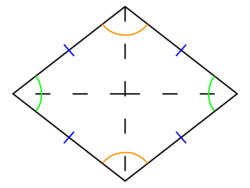Rhombus
A rhombus or rhomb is a polygon of four sides of equal length. The angles of each pair of opposite vertices are equal. A rhombus is a special case of a parallelogram where all four sides are of equal length. A square is a special case of rhombus, where all four vertex angles are equal.
Properties
As with all quadrilaterals, the sum of the interior angles of a rhombus is 360 degrees; as with a parallelogram, the angles of opposite pairs of vertices are equal, and the sum of the angles of two adjacent vertices is 180 degrees.
The perimeter of a rhombus is equal to 4 times the length of one side. The area of a rhombus is equal to the length of the side multiplied by itself, multiplied by the sine of the angle between the sides. (Since sin(180-x)=sin(x) this does not depend on the choice of the angle.)
Any rhombus can tile a plane with no voids.
